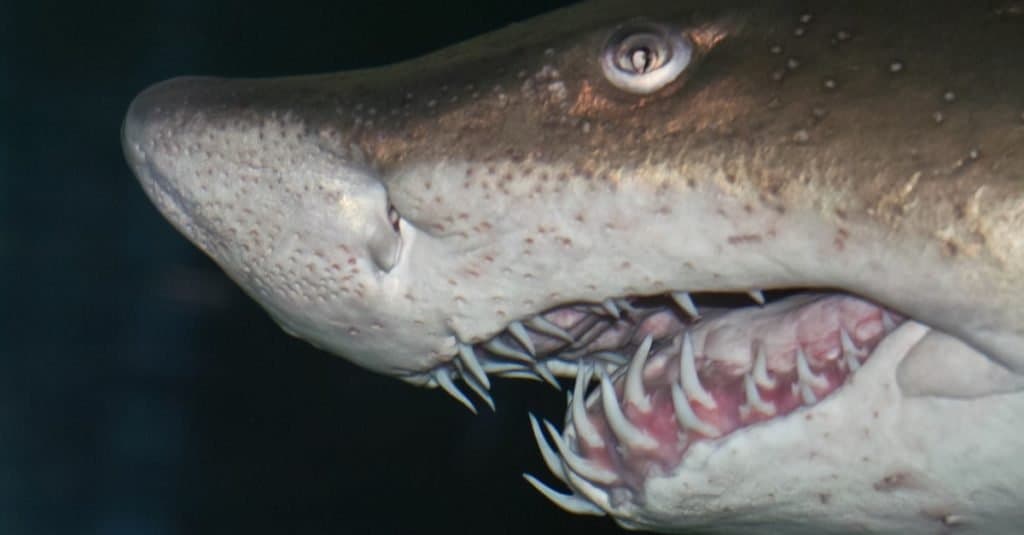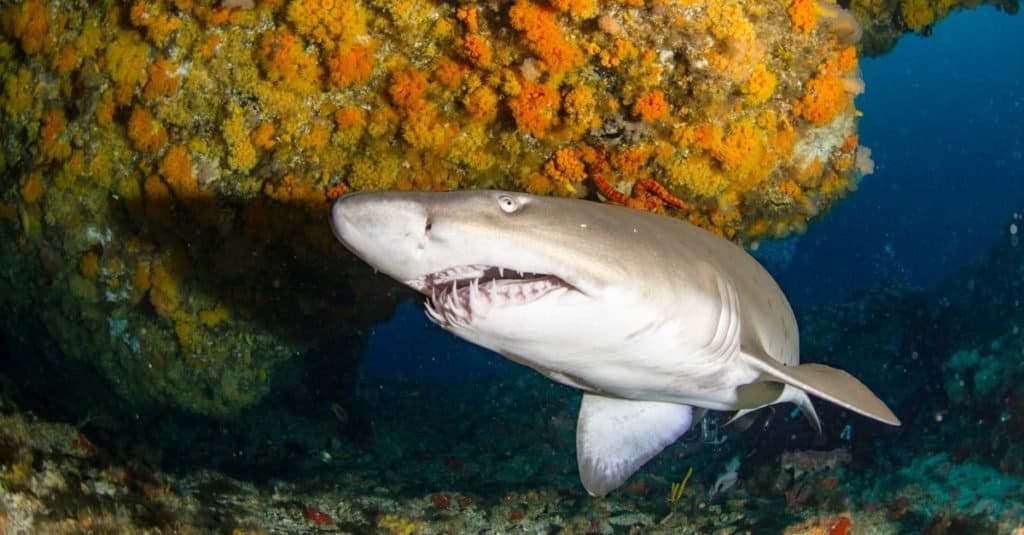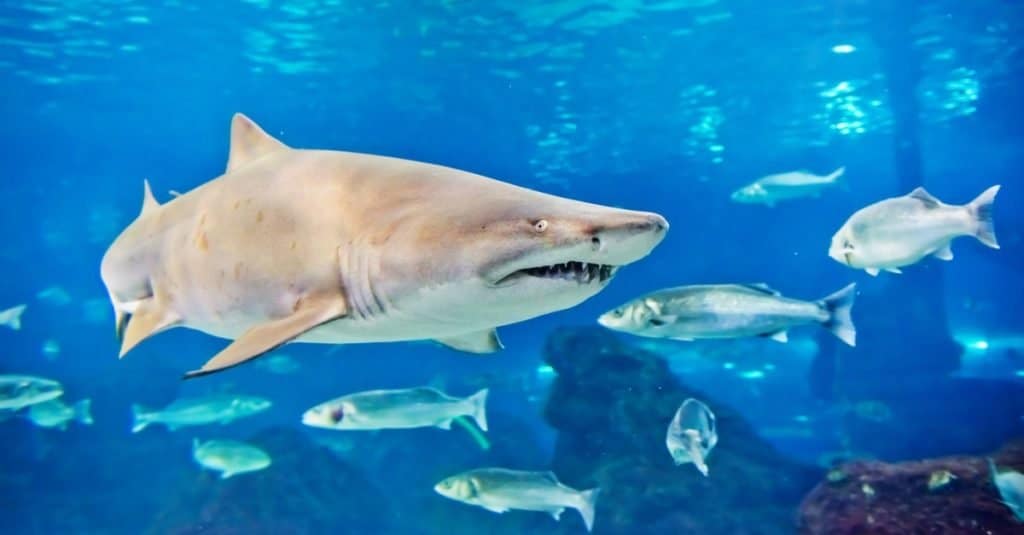Sharks are often referred to as bloodthirsty murderers because they are among the ocean’s most renowned and capable predators. According to experts, there are around 500 species of shark, which make up between 14 and 30 shark families. One of the most unique types of sharks is the sand tiger shark which belongs to a genus of sharks called Carcharias, and its scientific name is Carcharias taurus. ‘Taurus’ is the Latin word for a bull, while the name ‘Carcharias’ is derived from the Greek karkaharos, which means jagged or pointed.
Like most shark species, sand tiger sharks are big and strong and can tear living creatures apart with their teeth. Have you wondered whether or not these sharks have the same teeth as other sharks? This article addresses everything you’ve ever wanted to know about the sand tiger teeth.
How To Identify Sand Tiger Sharks
Like some other shark species, sand tiger sharks have robust, torpedo-shaped bodies with pointy heads and snouts shaped like cones. Most sand tiger sharks have white undersides and brownish-gray tops with rust-colored markings. Additionally, they have an eye-catching, oblong tail with a notched upper lobe that is much longer than the lower one. Generally, sand tiger sharks grow as long as 10 feet and weigh as much as over 100 pounds. Unlike other shark species with bigger males, female sand tiger sharks are significantly larger than males.
What Do Sand Tiger Sharks Eat?
Fish, smaller sharks, lobsters, squid, rays, and skates are some prey items that the sand tiger prefers to eat. Occasionally, these sharks cooperate by gathering smaller fish into a school that takes the shape of a ball before attacking them. When in a feeding frenzy, sand tigers can be even more deadly since they will attack anything in their immediate vicinity.
Sand tiger sharks can be found in warm water habitats in several parts of the world. Some of the easiest places to find them include the east and south coasts of the United States, parts of the southeast coast of South America, the Mediterranean, and the coasts of Africa, Australia, China, and Indochina. Although these sharks are capable of diving to a depth of nearly 600 feet, they favor shallow waters where they may hunt covertly and at night.
Sand Tiger Shark Teeth

Due to the disorganized arrangement pattern of their teeth, sand tiger sharks are also called spotted ragged tooth sharks.
©MP cz/Shutterstock.com
One of the most peculiar things about sand tiger sharks is their teeth; it is probably the first thing anyone notices about them. These sharks have a mouthful of sharp teeth that protrude in all directions, even when the mouth is shut. Their huge teeth are arranged in three rows on each side of the upper jaw midline in their mouth. Due to the disorganized arrangement pattern of their teeth, these sharks are also called spotted ragged tooth sharks.
How Many Teeth Do Sand Tiger Sharks Have?

Sand tiger sharks can have between 44 and 48 teeth in their upper jaws.
©Stefan Pircher/Shutterstock.com
Because of how disorganized their teeth are, many people wonder how many teeth these sharks have. The number of teeth sand tiger sharks have vary. In their upper jaws, these sharks can have between 44 and 48 teeth. On the other hand, their lower jaws have anywhere between 41 and 46 teeth. These sharks also have numerous small teeth in the corners of their mouths.
On average, sharks have between 50 and 300 teeth at any one time. The reason for this is that, unlike many other animals, sharks have many rows of teeth, and sand tiger sharks are no different. The total number of teeth a sand tiger shark has is difficult to determine, as these sharks usually have three rows of teeth on each jaw.
What Types of Teeth Do Sand Tiger Sharks Have?
Sand tiger sharks have pointed teeth that stick out from their jaws to catch prey. A single shark has hundreds of teeth and loses hundreds of teeth over its lifetime as new ones develop. An enameloid hydroxyapatite, which is also present in the outer layer of human teeth, makes up the teeth of sand tiger sharks. Their teeth also contain oxygen atoms from the water(s) the shark spent its lifetime in, and the temperature and salinity of said water(s) can be calculated by examining the oxygen.
However, some of the teeth in a sand tiger shark’s jaw indicate a different habitat from where the shark is living since some of them move around frequently in their lifetime, and their teeth are constantly moving forward in a manner akin to a conveyor belt. Sand tiger shark teeth have short lateral cusplets and long, narrow primary cusps. At the symphysis, there are a few little intermediate teeth that divide the top anterior teeth.
The type of teeth sand tiger sharks have is also an indicator of their dietary choices. These sharks primarily have needle-like teeth that are so named because they are long and extremely sharp. These teeth come in handy for catching small to medium-sized fish, squid, and even tiny sharks. Also, it is easier for a sand tiger shark to grasp fish with narrow bodies thanks to their long, pointed teeth. Other sharks that have these types of teeth include the bull shark, which is also well-known for its ability to live in freshwater environments like lakes and rivers.
Do Sand Tiger Sharks Bite Humans?

Sand tiger sharks generally avoid humans.
©Valeri Potapova/Shutterstock.com
Although sharks are generally dangerous and should be avoided, the ragged teeth of sand tiger sharks make them look even more dangerous than the average shark. Though the sand tiger prowls the oceans with cold, staring eyes and a mouthful of sharp teeth, they are not as menacing as they look. These sharks generally avoid human contact, and even in the face of captivity, they mostly remain calm. However, because they are large predators and have a mouth full of sharp teeth, it is advisable to avoid bothering sand tiger sharks.
Also, these sharks have a similar jaw structure to great white sharks, and although their precise bite force is unknown, there is enough evidence to prove that the bite force of a sand tiger shark is almost as powerful as that of a great white shark, which can produce a bite force of up to 4,000 PSI.
Up Next:
Are Sand Tiger Sharks Dangerous Or Aggressive?
10 Incredible Sand Tiger Shark Facts
Tiger Shark vs Sand Tiger Shark: What are the Differences?
The photo featured at the top of this post is © Stefan Pircher/Shutterstock.com
Sources
- AnimalSake, Available here: https://animalsake.com/sand-tiger-shark-teeth
- ScienceAlert, Available here: https://www.sciencealert.com/shark-teeth-from-millions-of-years-ago-solve-mystery-of-earth-s-ancient-climate
- Florida Museum, Available here: https://www.floridamuseum.ufl.edu/discover-fish/species-profiles/carcharias-taurus/
Thank you for reading! Have some feedback for us? Contact the AZ Animals editorial team.






